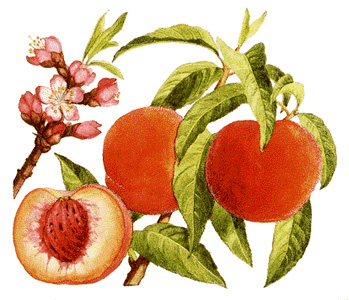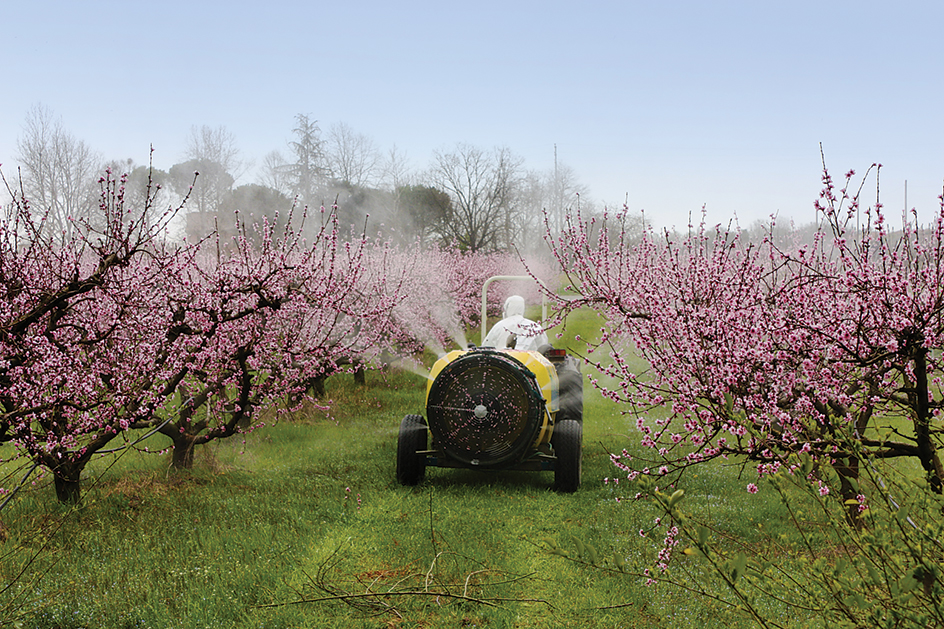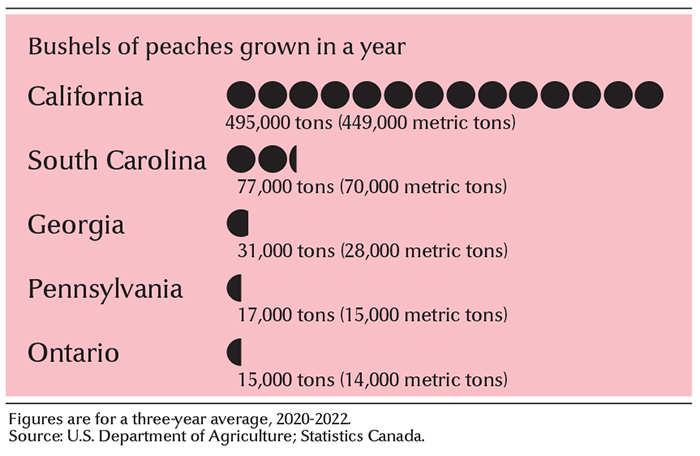Peach is a roundish, yellow to reddish, edible fruit. It has a hard, deeply pitted stone. Its flesh may be soft or quite firm. Among deciduous (leaf-shedding) tree fruits, only the apple and the pear are more widely distributed throughout the world than the peach. Peach trees grow in most temperate regions.

Horticulturists (plant scientists) believe that China is the native home of the peach. They believe the trees grew there at least 4,000 years ago. The peach was spread throughout Europe by the Romans. Spanish explorers brought the peach to the Americas as early as the 1500’s, and English colonists also brought peaches in the 1600’s. The United States is one of the world’s leading producers of peaches. Many peach trees are planted in commercial orchards, and some are cultivated in gardens as ornamentals.
Peach trees grow 15 to 25 feet (4.6 to 7.6 meters) high. Their slender leaves have toothed edges. Flowers appear before the leaves. The delicate pink blossoms may be large and showy, but sometimes are quite small. They appear early in the spring and can be injured by late frosts. Most commercial peach orchards are located in regions where there are few late frosts. Clear, hot weather during the growing season is best for peaches. They are grown southward from the Great Lakes region of the Midwest into the Deep South, and along the Atlantic and Pacific coasts.
Cultivars.
There are many cultivars (varieties produced by selective breeding) of peaches. They ripen from early summer to fall–some as late as October. Peaches are called freestone or clingstone, according to how difficult it is to remove the pit from the fruit. The fruit of freestone peaches is usually softer than that of clingstones. But some cultivars of clingstones are very mellow, with fine aroma and excellent texture.
Perhaps the best-known peach cultivar is Elberta, a freestone. It originated in 1870 in Marshallville, Ga. Other well-known freestone cultivars are J. H. Hale, Redhaven, Hiley, Halehaven, July Elberta, and Golden Jubilee. Important clingstone cultivars include Fortuna, Paloro, Johnson, Gaume, and Sims. Nectarines are similar to peaches. The two fruits are essentially alike except for the skins, and the trees are identical (see Nectarine).
Growing peach trees.
Most commercially important cultivars of peach are reproduced by attaching a bud of the desired cultivar to a rootstock from a different cultivar. This procedure is called budding. Rootstock cultivars are chosen on the basis of their ability to produce stronger or dwarf-type trees. One-year-old rootstocks are budded in late summer. The newly budded trees lie dormant until the next spring, when the buds are forced into growth. The age of a peach tree is determined by the age of the bud even though the rootstock is one year older.
Cultivation.
Peach trees grow best on a deep, well-drained, medium-textured soil, such as a sandy loam. Growers plant standard-sized trees 18 to 25 feet (5.5 to 7.6 meters) apart in the orchard. But those trees grown on dwarfing rootstocks are planted 12 to 15 feet (3.7 to 4.6 meters) apart. A peach orchard begins to bear large crops about 3 or 4 years after it is planted. If the trees are healthy, they live about 20 years. They reach peak production when they are 8 to 12 years old. A single tree may produce from 4 to 10 bushels of peaches. A bushel of peaches weighs about 50 pounds (23 kilograms).
Peach trees must be watered regularly. The amount of water required varies with climate, soil texture and depth, and depth of the root system. Enough water must be used to wet the entire root system. Cultivation of the orchard is necessary to destroy weeds, which compete with the trees for water and mineral nutrients in the soil. Chemical sprays are often used to control weeds.
Peach trees need various mineral nutrients for normal growth. Most of these occur in sufficient quantity in the soil. But usually nitrogen must be added. Special fertilizers are used to supply this element.
Pruning
is essential for good fruit production. Peach trees are pruned more heavily than most other fruit trees. Trees are pruned low to make spraying and picking easier. Because the fruit is produced on shoots of the previous season’s growth, about a third of the last year’s growth is kept. All the rest is cut off. The trees produce so many peaches that the fruit must be thinned. Growers remove some peaches early in the season. This technique increases the size and improves the quality of the fruit that remains. Tree-ripened peaches have the best flavor. They are harvested when ripe but still firm.
Uses.
Fresh peaches are eaten as a delicacy. But many of the fruits are canned, principally those of the clingstone cultivars. Some peaches are frozen for commercial use, and a few of the fruits are dried. Pastries and preserves can be made from peaches. Distillers sometimes make brandy from them.
Diseases.
A number of diseases attack the peach. Brown rot, a fungus, causes serious damage. It rots the fruit and prevents the flowers from opening. Peach leaf curl is very troublesome. To prevent this disease, growers spray the tree early in spring before the leaves emerge. Other fungi cause mildew, rust, and blight. Sprays of organic chemical fungicides are used to control these diseases.
Peach trees are susceptible to many virus diseases. Among the serious ones are peach yellows, X-disease, Western X-disease, ring spot, and peach mosaic. Trees infected with these diseases must be uprooted.
Insects.
Several insects damage peach trees. The peach twig borer, the larva of a moth, may bore into the fruit. But usually it bores into the trunk and branches, sometimes killing the tree. The peach moth larva destroys twigs and fruit. Many other moth larvae and beetles prey on the foliage, as do several kinds of caterpillars. Organic chemical insecticide sprays are used to control insects. Some chemicals for disease and insect sprays may be combined.

Production.
Peaches are grown throughout the world. The leading peach-growing countries are China, Greece, Italy, Spain, and Turkey. Other important peach-growing countries include Algeria, Brazil, Chile, Egypt, France, Iran, South Korea, and the United States. About three-fourths of the peaches grown in the United States come from California. Clingstone cultivars make up over half of California’s peach crop. Ontario leads the Canadian provinces in peach production. The province grows about three-fourths of Canada’s total crop.

